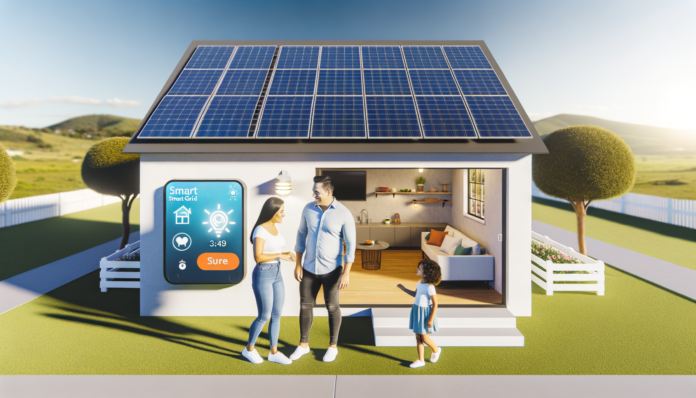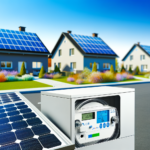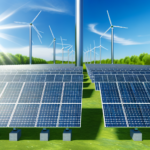Introduction to Smart Grids and Solar Power
Understanding Smart Grids
The term “smart grid” refers to an advanced electrical grid that leverages modern technology to enhance the efficiency, reliability, and sustainability of electricity delivery. Unlike traditional grids, which operate on a one-way flow of electricity from power plants to consumers, smart grids enable a two-way flow of both electricity and information. This real-time communication between power generators, distribution networks, and consumers allows for more dynamic and responsive energy management.
Smart grids are designed to:
- Enhance reliability: By reducing the impact of power outages and improving grid resilience.
- Optimize energy distribution: By balancing supply and demand, thereby reducing energy wastage.
- Accommodate renewable energy sources: By integrating renewable energy into the grid seamlessly.
- Empower consumers: By providing them with real-time data to make informed energy consumption choices.
Key components of smart grids include advanced metering infrastructure (AMI), distribution automation, and demand response programs. These technologies collectively contribute to a more efficient and resilient energy system, capable of meeting the complex demands of modern electricity consumption.
The Rise of Solar Power
Solar power has emerged as a leading renewable energy source, driven by technological advancements and a growing awareness of environmental sustainability. Solar energy harnesses the power of the sun through photovoltaic (PV) panels or concentrated solar power (CSP) systems to generate electricity. The adoption of solar power has been accelerated by several factors:
- Decreasing Costs: The cost of solar panels has significantly decreased over the past decade, making solar energy more accessible to homeowners and businesses.
- Environmental Benefits: Solar power is a clean energy source that reduces greenhouse gas emissions and dependence on fossil fuels.
- Government Incentives: Many governments offer tax credits, rebates, and other incentives to encourage the adoption of solar energy.
- Technological Innovations: Advances in solar technology, such as improved panel efficiency and energy storage solutions, have made solar power more viable and efficient.
As a result, solar power installations have surged globally, contributing to a more sustainable and diversified energy landscape.
Why Integrate Solar Power into Smart Grids?
Integrating solar power into smart grids offers numerous benefits that align with the goals of modern energy systems. Here are some key reasons why this integration is advantageous:
- Enhanced Grid Stability: Smart grids can manage the intermittent nature of solar power by using advanced algorithms and energy storage solutions to balance supply and demand.
- Increased Renewable Energy Adoption: Smart grids facilitate the seamless integration of solar power, encouraging more widespread use of renewable energy sources.
- Cost Efficiency: By optimizing energy distribution and reducing peak demand, smart grids can lower electricity costs for consumers and utilities alike.
- Environmental Impact: Integrating solar power into smart grids reduces reliance on fossil fuels, thereby decreasing carbon emissions and promoting environmental sustainability.
- Consumer Empowerment: Smart grids provide consumers with real-time data on their energy usage, enabling them to make more informed decisions and potentially generate their own power through solar installations.
In summary, the integration of solar power into smart grids represents a significant step towards a more resilient, efficient, and sustainable energy future. By leveraging the strengths of both technologies, we can create a more adaptable and environmentally friendly energy system that meets the needs of the 21st century.
Benefits of Integrating Solar Power into Modern Homes
Environmental Impact
Integrating solar power into modern homes significantly reduces the environmental footprint. Solar energy is a clean, renewable resource that generates electricity without emitting greenhouse gases or other pollutants. By harnessing the power of the sun, homeowners can decrease their reliance on fossil fuels, which are major contributors to air pollution and climate change. The reduction in carbon emissions from using solar power helps mitigate global warming and promotes a healthier environment. Additionally, solar panels have a long lifespan and require minimal maintenance, further reducing their environmental impact over time.
Cost Savings
One of the most compelling benefits of integrating solar power into homes is the potential for substantial cost savings. Solar panels convert sunlight into electricity, which can significantly reduce or even eliminate monthly utility bills. Over time, the savings on energy costs can offset the initial investment in solar panel installation. Moreover, many regions offer incentives such as tax credits, rebates, and net metering programs, which allow homeowners to sell excess energy back to the grid. These financial incentives can further reduce the payback period and enhance the overall return on investment.
Energy Independence
Solar power provides homeowners with a degree of energy independence that is not possible with traditional energy sources. By generating their own electricity, homeowners are less vulnerable to fluctuations in energy prices and supply disruptions. This independence is particularly valuable in areas prone to power outages or where the energy grid is less reliable. With the addition of energy storage solutions, such as solar batteries, homeowners can store excess energy produced during the day for use at night or during emergencies, ensuring a continuous power supply.
Enhanced Resilience
Integrating solar power into homes enhances resilience against natural disasters and other emergencies. Solar energy systems, especially when paired with battery storage, can provide a reliable source of power during grid outages caused by storms, earthquakes, or other disruptions. This capability is crucial for maintaining essential services such as lighting, refrigeration, and communication during emergencies. Furthermore, a resilient energy system can support community efforts in disaster recovery by reducing the strain on public resources and infrastructure.
In summary, the integration of solar power into modern homes offers numerous benefits, including a positive environmental impact, significant cost savings, increased energy independence, and enhanced resilience. These advantages make solar energy an attractive option for homeowners looking to create a sustainable and self-sufficient living environment.
Components of a Smart Grid System
Smart Meters
Smart meters are the cornerstone of any smart grid system. Unlike traditional meters, which only measure total consumption, smart meters provide real-time data on energy usage. This allows both consumers and utility companies to monitor and manage electricity consumption more effectively. **Smart meters** enable two-way communication between the utility and the consumer, offering insights into energy usage patterns and helping to identify opportunities for energy savings. They also facilitate dynamic pricing models, where electricity costs can vary based on demand, encouraging consumers to use energy during off-peak hours.
Energy Storage Solutions
Energy storage solutions are critical for balancing supply and demand in a smart grid system, especially when integrating renewable energy sources like solar power. **Battery storage systems** can store excess energy generated during sunny periods and release it when solar production is low, such as during the night or on cloudy days. This not only ensures a stable energy supply but also enhances the resilience of the grid. Advanced energy storage technologies, such as lithium-ion batteries and emerging solid-state batteries, are becoming more efficient and cost-effective, making them a viable option for modern homes.
Home Energy Management Systems
Home Energy Management Systems (HEMS) are designed to optimize energy consumption within a household. These systems use data from smart meters and other connected devices to provide real-time insights and control over energy use. **HEMS** can automate energy-saving actions, such as adjusting thermostat settings, turning off lights, or managing the charging of electric vehicles. By integrating with smart appliances and renewable energy sources, HEMS can significantly reduce energy costs and carbon footprints. They also offer the convenience of remote monitoring and control via smartphones or other devices.
Grid Communication Technologies
Effective communication is the backbone of a smart grid system. Grid communication technologies enable the seamless exchange of data between various components of the grid, from power plants to individual homes. **Advanced communication protocols** like Zigbee, Wi-Fi, and cellular networks are used to ensure reliable and secure data transmission. These technologies support real-time monitoring and control, allowing for quick responses to changes in energy demand or supply. They also facilitate the integration of distributed energy resources, such as rooftop solar panels, into the grid, ensuring a more flexible and resilient energy system.
In summary, the components of a smart grid system—smart meters, energy storage solutions, home energy management systems, and grid communication technologies—work together to create a more efficient, reliable, and sustainable energy infrastructure. By leveraging these advanced technologies, modern homes can better integrate solar power, reduce energy costs, and contribute to a greener future.
Steps to Integrate Solar Power into Your Home
Assessing Your Energy Needs
Before diving into the world of solar power, it’s crucial to understand your home’s energy consumption. Start by analyzing your electricity bills to identify your average monthly usage and peak consumption periods. Consider factors such as the number of occupants, types of appliances, and lifestyle habits that affect energy use. Conducting an energy audit can also help pinpoint areas where energy is wasted, such as poor insulation or outdated appliances. This information is essential for sizing your solar panel system accurately and ensuring it meets your energy demands.
Choosing the Right Solar Panels
Selecting the appropriate solar panels is a critical step in integrating solar power into your home. There are various types of solar panels available, including monocrystalline, polycrystalline, and thin-film panels. Monocrystalline panels are known for their high efficiency and durability, making them a popular choice for residential installations. Polycrystalline panels are slightly less efficient but more cost-effective. Thin-film panels are flexible and lightweight but generally less efficient. Consider factors such as efficiency, cost, and available roof space when choosing the right panels for your home.
Installing Energy Storage Systems
Energy storage systems, such as solar batteries, play a vital role in maximizing the benefits of your solar power system. These batteries store excess energy generated during the day for use during nighttime or cloudy days, enhancing energy independence and security. When selecting a battery, consider its capacity, lifespan, and compatibility with your solar panels and inverter. Advanced energy storage solutions can also integrate with home energy management systems, allowing you to optimize when and how stored energy is used, further reducing reliance on the grid.
Connecting to the Smart Grid
Integrating your solar power system with the smart grid allows for efficient energy management and potential financial benefits. Smart grids enable two-way communication between your home and the utility company, allowing you to sell excess energy back to the grid through net metering programs. This not only reduces your electricity bills but also supports the overall stability of the grid. Ensure that your solar inverter is compatible with smart grid technology and that you have the necessary permissions and agreements in place with your utility provider.
Monitoring and Maintenance
Regular monitoring and maintenance are essential to ensure the optimal performance of your solar power system. Utilize monitoring tools provided by your solar inverter or a dedicated home energy management system to track energy production, consumption, and storage in real-time. Set up alerts for any anomalies, such as sudden drops in energy production or unexpected spikes in consumption, so you can address issues promptly. Routine maintenance, such as cleaning solar panels and checking battery health, also plays a crucial role in maintaining system efficiency and longevity. By actively monitoring and maintaining your system, you can ensure that your solar-powered home continues to deliver maximum benefits in terms of energy efficiency, cost savings, and sustainability.
Challenges and Solutions
Initial Investment Costs
One of the most significant barriers to integrating solar power into modern homes is the initial investment cost. The expenses associated with purchasing and installing solar panels, energy storage systems, and smart grid technologies can be substantial. For many homeowners, this upfront cost can be a deterrent despite the long-term savings and environmental benefits.
- Solar Panels: High-quality solar panels can be expensive, and the cost varies depending on the size and efficiency of the system.
- Energy Storage: Battery storage systems, such as the Tesla Powerwall, add to the overall cost but are essential for maximizing the use of solar energy.
- Smart Grid Integration: Upgrading to a smart grid-compatible system involves additional costs for smart meters, inverters, and home energy management systems.
Solutions and Innovations
To mitigate these costs, several solutions and innovations are emerging:
- Government Incentives: Many governments offer tax credits, rebates, and grants to offset the initial costs of solar installations.
- Financing Options: Solar loans, leases, and power purchase agreements (PPAs) provide flexible financing options, making solar power more accessible.
- Community Solar Projects: Shared solar projects allow multiple households to benefit from a single solar installation, reducing individual costs.
Technical Challenges
Integrating solar power with smart grids involves several technical challenges. These include ensuring compatibility between different components, managing energy storage, and maintaining system efficiency.
- Compatibility: Different brands and types of solar panels, inverters, and smart devices may not always work seamlessly together.
- Energy Storage Management: Efficiently storing and distributing solar energy requires advanced battery management systems.
- System Efficiency: Maintaining high efficiency in energy conversion and distribution is crucial for maximizing the benefits of solar power.
Solutions and Innovations
Technological advancements are addressing these challenges:
- Standardization: Industry standards are being developed to ensure compatibility between different components.
- Advanced Inverters: Smart inverters optimize energy conversion and can communicate with other smart devices to balance energy loads.
- AI and Machine Learning: These technologies are being used to predict energy usage patterns and optimize energy distribution.
Regulatory and Policy Issues
Regulatory and policy issues can also pose challenges to the integration of solar power into smart grids. These include zoning laws, building codes, and utility regulations that may limit the installation and use of solar energy systems.
- Zoning Laws: Local zoning laws may restrict where solar panels can be installed.
- Building Codes: Compliance with building codes can add complexity and cost to solar installations.
- Utility Regulations: Policies on net metering and grid interconnection can vary widely, affecting the financial viability of solar projects.
Solutions and Innovations
Efforts to address these issues include:
- Policy Advocacy: Advocacy groups are working to promote favorable policies and regulations for solar energy.
- Streamlined Permitting: Some regions are adopting streamlined permitting processes to reduce the time and cost of solar installations.
- Utility Partnerships: Collaborations between solar providers and utilities can help align interests and create supportive regulatory environments.
Solutions and Innovations
Despite the challenges, numerous solutions and innovations are paving the way for more widespread adoption of solar power in smart grids.
- Technological Advancements: Continuous improvements in solar panel efficiency, battery storage, and smart grid technologies are making solar power more viable and cost-effective.
- Integrated Energy Systems: Comprehensive energy management systems that integrate solar power, storage, and smart grid technologies are simplifying the process for homeowners.
- Community Initiatives: Community solar projects and cooperative models are enabling broader access to solar power, especially in areas where individual installations may not be feasible.
By addressing these challenges through innovative solutions and supportive policies, the integration of solar power into modern homes can become more accessible, efficient, and beneficial for both homeowners and the environment.
Case Studies and Real-World Examples
Off-Grid Living
Off-grid living represents a lifestyle choice where individuals or communities aim to be self-sufficient by disconnecting from the traditional power grid. This approach often involves the use of renewable energy sources, particularly solar power, to meet energy needs.
One notable example is the Earthship community in Taos, New Mexico. Earthships are sustainable homes built with natural and recycled materials, designed to be self-sufficient. These homes utilize solar panels to generate electricity, which is stored in battery systems for use during non-sunny periods. The integration of smart grid technology allows residents to monitor and manage their energy consumption efficiently, ensuring that they remain energy-independent.
The benefits of off-grid living include reduced utility bills, a smaller carbon footprint, and increased resilience to power outages. However, the initial investment in solar panels, batteries, and smart home systems can be substantial. Despite this, many off-grid enthusiasts find the long-term savings and environmental benefits to be well worth the upfront costs.
Urban Smart Homes
Urban smart homes are modern residences equipped with advanced technologies to enhance comfort, security, and energy efficiency. The integration of solar power into these homes is becoming increasingly common, driven by the desire to reduce energy costs and environmental impact.
A prime example is the SonnenCommunity in Germany. This community consists of homes equipped with solar panels and SonnenBatterie storage systems. The smart grid technology enables these homes to share excess solar energy with each other, creating a decentralized energy network. Homeowners can monitor their energy production and consumption in real-time through a mobile app, optimizing their energy usage and reducing reliance on the traditional power grid.
The benefits of urban smart homes include significant cost savings on energy bills, reduced carbon emissions, and enhanced energy security. Additionally, many governments offer incentives and rebates for installing solar panels and smart home systems, making this an attractive option for urban dwellers.
Community Solar Projects
Community solar projects are collaborative initiatives where multiple households or businesses invest in a shared solar power system. These projects are particularly beneficial for individuals who cannot install solar panels on their own properties due to space, shading, or financial constraints.
One successful example is the Brooklyn Microgrid in New York City. This project allows residents to buy and sell solar energy within their community using blockchain technology. Solar panels installed on rooftops generate electricity, which is then distributed through a local microgrid. Participants can trade energy credits, ensuring that excess solar power is utilized efficiently within the community.
Community solar projects offer numerous benefits, including increased access to renewable energy, cost savings, and the promotion of local energy resilience. They also foster a sense of community and collective responsibility towards sustainable living. However, these projects require careful planning, coordination, and investment to be successful.
In conclusion, real-world examples of off-grid living, urban smart homes, and community solar projects demonstrate the transformative potential of integrating solar power with smart grid technology. These case studies highlight the diverse ways in which individuals and communities can embrace sustainable living, reduce their carbon footprints, and achieve energy independence.
Future Trends in Smart Grids and Solar Power
Advancements in Solar Technology
The future of solar technology is incredibly promising, with continuous advancements making solar power more efficient and accessible. Innovations such as bifacial solar panels, which capture sunlight on both sides, and perovskite solar cells, known for their high efficiency and low production costs, are set to revolutionize the industry. Additionally, the development of solar skins, which allow panels to blend seamlessly with building aesthetics, is making solar installations more appealing to homeowners. These technological strides are not only enhancing the efficiency of solar power but also reducing the overall cost, making it a more viable option for a broader range of consumers.
The Role of Artificial Intelligence
Artificial Intelligence (AI) is playing a pivotal role in the evolution of smart grids and solar power. AI algorithms can predict energy production and consumption patterns, optimizing the distribution of solar energy across the grid. Machine learning models are being used to forecast weather conditions, enabling more accurate predictions of solar power generation. Furthermore, AI-driven energy management systems can autonomously adjust energy usage in real-time, ensuring maximum efficiency and cost savings. The integration of AI into smart grids is not just enhancing operational efficiency but also paving the way for more resilient and adaptive energy systems.
Policy and Market Trends
Government policies and market trends are crucial in shaping the future of smart grids and solar power. Incentives such as tax credits, rebates, and feed-in tariffs are encouraging the adoption of solar energy. Policies aimed at reducing carbon emissions and promoting renewable energy sources are driving investments in smart grid technologies. On the market side, the decreasing cost of solar panels and energy storage solutions is making solar power more competitive with traditional energy sources. Additionally, the rise of community solar projects, where multiple households share the benefits of a single solar installation, is democratizing access to solar energy.
The Vision for a Sustainable Future
The integration of smart grids and solar power is central to the vision of a sustainable future. By harnessing renewable energy sources and leveraging advanced technologies, we can create an energy ecosystem that is both efficient and environmentally friendly. The ultimate goal is to achieve a zero-carbon grid, where renewable energy sources like solar power meet all our energy needs. This vision includes not only individual homes but also entire communities and cities powered by clean energy. As we move towards this future, the collaboration between technology innovators, policymakers, and consumers will be essential in making sustainable living a reality for all.






